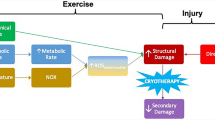Abstract
Cold-induced vasodilatation (CIVD) is proposed to be a protective response to prevent cold injuries in the extremities during cold exposure, but the laboratory-based trainability of CIVD responses in the hand remains equivocal. Therefore, we investigated the thermal response across the fingers with repeated local cold exposure of the whole hand, along with the transferability of acclimation to the fingers of the contralateral hand. Nine healthy subjects immersed their right hand up to the styloid process in 8°C water for 30 min daily for 13 days. The left hand was immersed on days 1 and 13. Skin temperature was recorded on the pads of the five fingertips and the dorsal surface of the hand. The presence of CIVD, defined as an increase in finger skin temperature of 0.5°C at any time during cooling, occurred in 98.5% of the 585 (9 subjects × 5 sites × 13 trials) measurements. Seven distinct patterns of thermal responses were evident, including plateaus in finger temperature and superimposed waves. The number (N) of CIVD waves decreased in all digits of the right hand over the acclimation period (P = 0.02), from average (SD) values ranging from 2.7 (1.7) to 3 (1.4) in different digits on day 1, to 1.9 (0.9) and 2.2 (0.7) on day 13. Average (SD) finger skin temperature (T avg) ranged from 11.8 (1.4)°C in finger 5 to 12.7 (2.8)°C in finger 3 on day 1, and then decreased significantly (P < 0.001) over the course of the training immersions, attaining values ranging from 10.8 (0.9)°C in finger 4 to 10.9 (0.9)°C in finger 2 on day 13. In the contralateral hand, N was reduced from 2.5 to 1.5 (P < 0.01) and T avg by ∼2°C (P < 0.01). No changes were observed in thermal sensation or comfort of the hand over the acclimation. We conclude that, under conditions of whole-hand immersion in cold water, CIVD is not trainable and may lead to systemic attenuation of thermal responses to local cooling.

Similar content being viewed by others
References
Adams T, Smith RE (1962) Effect of chronic local cold exposure on finger temperature responses. J Appl Physiol 17:317–322
Bergersen TK, Hisdal J, Walloe L (1999) Perfusion of the human finger during cold-induced vasodilatation. Am J Physiol 276:R731–R737
Brown GM, Page J (1952) The effect of chronic exposure to cold on temperature and blood flow of the hand. J Appl Physiol 5:221–227
Chen F, Liu ZY, Holmer I (1996) Hand and finger skin temperatures in convective and contact cold exposure. Eur J Appl Physiol Occup Physiol 72:372–379
Cheung SS, Mekjavic IB (2007) Cold-induced vasodilatation is not homogenous or generalizable across the hand and feet. Eur J Appl Physiol 99:701–705
Daanen HA (2003) Finger cold-induced vasodilation: a review. Eur J Appl Physiol 89:411–426
Fox RH, Wyatt HT (1962) Cold-induced vasodilatation in various areas of the body surface of man. J Physiol 162:289–297
Geurts CL, Sleivert GG, Cheung SS (2005) Local cold acclimation of the hand impairs thermal responses of the finger without improving hand neuromuscular function. Acta Physiol Scand 183:117–124
Geurts CL, Sleivert GG, Cheung SS (2006) Central and peripheral factors in thermal, neuromuscular, and perceptual adaptation of the hand to repeated cold exposures. Appl Physiol Nutr Metab 31:110–117
LeBlanc J, Dulac S, Cote J, Girard B (1975) Autonomic nervous system and adaptation to cold in man. J Appl Physiol 39:181–186
Lewis T (1930) Observations upon the reactions of the vessels of the human skin to cold. Heart 15:177–208
Meehan JP (1955) Individual and racial variations in a vascular response to a cold stimulus. Mil Med 116:330–334
Miller LK, Irving L (1962) Local reactions to air cooling in an Eskimo population. J Appl Physiol 17:449–455
O’Brien C (2005) Reproducibility of the cold-induced vasodilation response in the human finger. J Appl Physiol 98:1334–1340
Paik KS, Kang BS, Han DS, Rennie DW, Hong SK (1972) Vascular responses of Korean ama to hand immersion in cold water. J Appl Physiol 32:446–450
Purkayastha SS, Selvamurthy W, Ilavazhagan G (1992) Peripheral vascular response to local cold stress of tropical men during sojourn in the Arctic cold region. Jpn J Physiol 42:877–899
Purkayastha SS, Ilavazhagan G, Ray US, Selvamurthy W (1993) Responses of Arctic and tropical men to a standard cold test and peripheral vascular responses to local cold stress in the Arctic. Aviat Space Environ Med 64:1113–1190
Reynolds LF, Mekjavic IB, Cheung SS (2007) Cold-induced vasodilatation in the foot is not homogenous or trainable over repeated cold exposure. Eur J Appl Physiol 102:73–78
Rintamaki H, Hassi J, Smolander J, Louhevaara V, Rissanen S, Oksa J, Laapio H (1993) Responses to whole body and finger cooling before and after an Antarctic expedition. Eur J Appl Physiol Occup Physiol 67:380–384
Savourey G, Barnavol B, Caravel JP, Feuerstein C, Bittel JH (1996) Hypothermic general cold adaptation induced by local cold acclimation. Eur J Appl Physiol Occup Physiol 73:237–244
Yoshimura H, Iida T (1952) Studies on the reactivity of skin vessels to extreme cold II. Factors governing the individual difference of the reactivity, or the resistance against frostbite. Jpn J Physiol 2:177–185
Acknowledgments
The authors wish to express their gratitude to the subjects for their participation. The study was supported, in part, by a Knowledge for Security and Peace grant from the Ministries of Defence and of Science (Republic of Slovenia).
Author information
Authors and Affiliations
Corresponding author
Rights and permissions
About this article
Cite this article
Mekjavic, I.B., Dobnikar, U., Kounalakis, S.N. et al. The trainability and contralateral response of cold-induced vasodilatation in the fingers following repeated cold exposure. Eur J Appl Physiol 104, 193–199 (2008). https://doi.org/10.1007/s00421-008-0727-5
Accepted:
Published:
Issue Date:
DOI: https://doi.org/10.1007/s00421-008-0727-5




